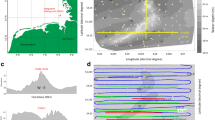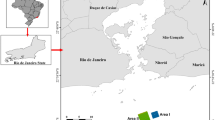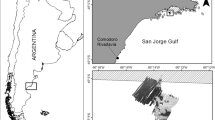Abstract
To determine the spatial resolution of sediment properties and benthic macrofauna communities in acoustic backscatter, the suitability of four acoustic seafloor classification devices (single-beam echosounder with RoxAnn and QTC 5.5 seafloor classification system, sidescan sonar with QTC Swathview seafloor classification, and multi-beam echosounder with QTC Swathview seafloor classification) was compared in a study area of approx. 6 km2 northwest of the island of Helgoland in the German Bight, southern North Sea. This was based on a simple similarity index between simultaneous sidescan sonar, single-beam echosounder and multi-beam echosounder profiling spanning the period 2011–2014. The results show a high similarity between seafloor classifications based on sidescan sonar and RoxAnn single-beam systems, in turn associated with a lower similarity for the multi-beam echosounder system. Analyses of surface sediment samples at 39 locations along four transects (0.1 m2 Van Veen grab) revealed the presence of sandy mud (southern and western parts), coarse sand, gravel and cobbles. Rock outcrops were identified in the north-eastern and eastern parts. A typical Nucula nitidosa–Abra alba community was found in sandy muds to muddy sands in the northern part, whereas the southern part is characterised by widespread occurrence of the ophiuroid brittle star Amphiura filiformis. A transitional N. nitidosa–A. filiformis community was detected in the central part. Moreover, the southern part is characterised by a high abundance of A. filiformis and its commensal bivalve Kurtiella bidentata. The high number of A. filiformis feeding arms (up to ca. 6,800 per m2) can largely explain the gentle change of backscatter intensity along the tracks, because sediment composition and/or seafloor structures showed no significant variability.










Similar content being viewed by others
References
Anderson JT, Van Holliday D, Kloser R, Reid DC, Simard Y (2008) Acoustic seabed classification: current practice and future directions. ICES J Mar Sci 65:1004–1011
Bartholomä A (2006) Acoustic bottom detection and seabed classification in the German Bight, southern North Sea. Geo-Mar Lett 26:177–184
Bartholomä A, Holler P, Schrottke K, Kubicki A (2011) Acoustic habitat mapping in the German Wadden Sea - comparison of hydroacoustic devices. J Coast Res SI 64:1–5
Bornhold BD, Collins WT, Yamanaka L (1999) Comparison of seabed characterization using sidescan sonar and acoustic classification techniques. In: Proc Canadian Coastal Conf, Victoria, Canada, 15 pp
Bray JR, Curtis JT (1957) An ordination of the upland forest communities of southern Wisconsin. Ecol Monogr 27:325–349
Brown CJ, Collier JS (2008) Mapping benthic habitat in regions of gradational substrata: an automated approach utilising geophysical, geological, and biological relationships. Estuar Coast Shelf Sci 78:203–214
Brown CJ, Mitchell A, Limpenny DS, Robertson MR, Service M, Golding N (2005) Mapping seabed habitats in the Firth of Lorn off the west coast of Scotland: evaluation and comparison of habitat maps produced using the acoustic ground-discrimination system. RoxAnn, and sidescan sonar. ICES J Mar Sci 62:790–802
BSH (2016) Guideline for seafloor mapping in German marine waters using high resolution sonars. BSH no 7201. Bundesamt für Seeschifffahrt und Hydrographie, Hamburg, Germany
Buchanan JB (1964) A comparative study of some features of the biology of Amphiura filiformis and Amphiura chiajei (Ophiuroidea) considered in relation to their distribution. J Mar Biol Assoc UK 44:565–576
Cadée CC (1984) Macrobenthos and macrobenthic remains in the Oyster Ground, North Sea. Neth J Sea Res 18:160–178
Capperucci RM, Bartholomä A (2012) Sediment vs topographic roughness: anthropogenic effects on acoustic seabed classification. In: Proc Hydro 2012, Rotterdam, p 47–52
Chivers RC, Emerson NC, Burns D (1990) New acoustic processing for underway surveying. Hydrogr J 56:9–17
Clarke KR, Gorley RN (2006) PRIMER v6: user manual/tutorial. PRIMER-E, Plymouth
Clarke KR, Green RH (1988) Statistical design and analysis for a “biological effects” study. Mar Ecol Prog Ser 46:213–226
Clarke KR, Warwick RM (2001) Change in marine communities: an approach to statistical analysis and interpretation, 2nd edn. PRIMER-E, Plymouth
Collins WT, Galloway JL (1998) Seabed classification and multibeam bathymetry: tool for multidisciplinary mapping. Sea Technol 39:45–49
Dean BJ, Ellis JT, Irlandi (2013) Measuring nearshore variability in benthic environments: an acoustic approach. Ocean Coast Manag 86:3–41
Degraer S, Moerkerke G, Rabaut M, Van Hoey G, Du Four I, Vincx M, Henriet J-P, Van Lancker V (2008) Very-high resolution side-scan sonar mapping of biogenic reefs of the tube-worm Lanice conchilega. Remote Sens Environ 112:3323–3328
European Union (2008) Directive 2008/56/EC of the European Parliament and of the Council of 17 June 2008 establishing a framework for community action in the field of marine environmental policy (Marine Framework Directive). In: Official Journal of the European Union, vol L164, p 19–40
Ferrini VL, Flood RD (2006) The effects of fine-scale surface roughness and grain size on 300 kHz multibeam backscatter intensity in sandy marine sedimentary environments. Mar Geol 228:153–172
Figge K (1981) Karte zur Sedimentverteilung in der Deutschen Bucht, Nr. 2900. Bundesamt für Seeschifffahrt und Hydrographie, Hamburg, Germany, scale 1:250,000
Flemming BW, Thum A (1978) The settling tube - a hydraulic method of grain size analysis of sands. Kiel Meeresforsch SI 4:82–95
Folk RL (1954) The distinction between grain size and mineral composition in sedimentary rock nomenclature. J Geol 62(4):344–359
Freitas R, Ricardo F, Pereira F, Sampaio L, Carvalho S, Gaspar M, Quintino V, Rodrigues AM (2011) Benthic habitat mapping: concerns using a combined approach (acoustic, sediment and biological data). Estuar Coast Shelf Sci 92:598–606
Gleason ACR (2009) Single-beam acoustic seabed classification in coral reef environments with application to the assessment of grouper and snapper habitat in the upper Florida Keys, USA. PhD Thesis, University of Miami, Coral Gables, FL
Gleason ACR, Eklund AM, Reid RP, Koch V (2006) Acoustic seabed classification, acoustic variability, and grouper abundance in a forereef environment. NOAA Prof Papers NMFS 5, p 38–47
Hammer Ø, Harper DAT, Ryan PD (2001) PAST: paleontological statistics software package for education and data analysis. Palaeontol Electron 4(1):1–9
Hartmann-Schröder G (1996) Teil 58. Annelida, Borstenwürmer, Polychaeta. 2. neubearb. Auflage. In: Dahl F, Schuhmann H (eds) Die Tierwelt Deutschlands und der angrenzenden Meeresteile nach ihren Merkmalen und nach ihrer Lebensweise. Zoologisches Museum Berlin, Jena
Hass HC, Bartsch I (2008) Acoustic kelp bed mapping in shallow rocky coasts - case study Helgoland. In: Doerffer R, Colijn F, van Beusekom J (eds) Observing the coastal sea - an Atlas of advanced monitoring techniques. LOICS Reports & Studies, no 33. GKSS Research Centre, Geesthacht, Germany, p 50–53
Hass HC, Mielck F, Fiorentino D, Papenmeier S, Holler P, Bartholomä A (2016) Seafloor monitoring west of Helgoland (German Bight, North Sea) using the acoustic ground discrimination system RoxAnn. Geo-Mar Lett. doi:10.1007/s00367-016-0483-1
Huff LC (2008) Acoustic remote sensing as a tool for habitat mapping in Alaska waters. In: Reynolds JR, Greene HG (eds) Marine habitat mapping technology for Alaska. Alaska Sea Grant College Program, University of Alaska Fairbanks. doi:10.4027/mhmta.2008.03
Josefson AB (1998) Resource limitation in marine soft sediments - differential effects of food and space in the association between the brittle-star Amphiura filiformis and the bivalve Mysella bidentata. Hydrobiologia 375(376):297–305
Kenny AJ, Cato I, Desprez M, Fader G, Schüttenhelm RTE, Side J (2003) An overview of seabed-mapping technologies in the context of marine habitat classification. ICES J Mar Sci 60:411–418
Kröncke I, Stoeck T, Wieking G, Palojärvi A (2004) Relationship between structural and functional aspects of microbial and macrofaunal communities in different areas of the North Sea. Mar Ecol Prog Ser 282:13–21
Kröncke I, Reiss H, Eggleton JD, Aldridge J, Bergman MJN, Cochrane S, Craeymeersch J, Degraer S, Desroy N, Dewarumez J-M, Duineveld G, Essink K, Hillewaert H, Lavaleye MSS, Moll A, Nehring S, Newell J, Oug E, Pohlmann T, Rachor E, Robertson M, Rumohr H, Schratzberger M, Smith R, Vanden Berghe E, van Dalfsen J, van Hoey G, Vincx M, Willems W, Rees HL (2011) Changes in North Sea macrofauna communities and species distribution between 1986 and 2000. Estuar Coast Shelf Sci 94:1–15
Krumbein WC, Aberdeen E (1937) The sediments of Barataria Bay. J Sediment Petrol 7:3–17
Kühne S, Rachor E (1996) The macrofauna of a stony sand area in the German Bight (North Sea). Helgoländer Meeresun 50:433–452
Künitzer A (1989) Factors affecting the population dynamics of Amphiura filiformis (Echinodermata: Ophiuroidea) and Mysella bidentata (Bivalvia: Galeommatacea) in the North Sea. In: Ryland JS, Tyler PA (eds) Reproduction, genetics and distributions of marine organisms. Proc 23rd Europ Mar Biol Symp. Olsen & Olsen, Fredensborg, Denmark, p 395–406
Künitzer A, Basford D, Craeymeersch JA, Dewarumez JM, Dörjes J, Duinveld GCA, Eleftheriou A, Heip C, Herman P, Kingston P, Niermann U, Rachor E, Ruhmor H, de Wilde PAJ (1992) The benthic infauna of the North Sea: species distribution and assemblages. ICES J Mar Sci 49:127–143
Loo L-O, Jonsson PR, Sköld M, Karlsson Ö (1996) Passive suspension feeding in Amphiura filiformis (Echinodermata: Ophiuroidea): feeding behaviour in flume flow and potential feeding rate of field populations. Mar Ecol Prog Ser 139:143–155
Lucieer V (2008) Object-oriented classification of sidescan sonar data for mapping benthic marine habitats. Int J Mar Sensing 29:905–921
Lurton X (2002) An introduction to underwater acoustics: principles and applications. Springer, London
Lurton X, Lamarche G (eds) (2015) Backscatter measurements by seafloor-mapping sonars. Guidelines and recommendations. http://geohab.org/wp-content/uploads/2014/05/BSWG-REPORT-MAY2015.pdf
Markert E, Holler P, Kröncke I, Bartholomä A (2013) Benthic habitat mapping of sorted bedforms using hydroacoustic and ground-truthing methods in a coastal area of the German Bight/North Sea. Estuar Coast Shelf Sci 129:94–104
Mazel C (1985) Side scan sonar record interpretation. Klein Associates Inc, Report 11230001 Rev 01
Micallef A, Le Bas TP, Huvenne VAI, Blondel P, Hühnerbach V (2012) A multi-method approach for benthic habitat mapping of shallow coastal areas with high-resolution multibeam data. Cont Shelf Res 39(40):14–26. doi:10.1016/j.csr.2012.03.008
Mielck F, Bartsch I, Hass HC, Wölfl A-C, Bürk D, Betzler C (2014) Predicting spatial kelp abundance in shallow coastal waters using the acoustic ground discrimination system RoxAnn. Estuar Coast Shelf Sci 143:1–11
Ockelmann KW, Muus K (1978) The biology, ecology and behaviour of the bivalve Mysella bidentata (Montagu). Ophelia 17:1–93
Pielou E (1969) An introduction to mathematical ecology. Wiley, New York
Preston JM (2006) Acoustic classification of seaweed and sediment with depth-compensated vertical echoes. In: Proc MTS/IEEE Oceans 2006 Conf, Boston, USA, p 1–5
Preston JM, Parrott DR, Collins WT (2003) Sediment classification based on repetitive multibeam bathymetry surveys of an offshore disposal site. In: Proc IEEE Oceans ’03 Conf, p 69–75
Preston JM, Christney AC, Beran LS, Collins WT (2004) Statistical seabed segmentation - From images and echoes to objective clustering. In: Proc 7th European Conf Underwater Acoustics, Delft, The Netherlands, p 813–813
Quester Tangent Corporation (2003) Mapping intertidal oysters with QTC View, North Inlet-Winyah Bay, South Carolina. QTC Technical Report SR41-03
Quester Tangent Corporation (2011) QTC Swathview 11.1. User manual and reference: DMN-SWVW-0000-R02
Rachor E, Nehmer P (2003) Erfassung und Bewertung ökologisch wertvoller Lebensräume in der Nordsee. Abschlussbericht F+E, Vorhaben FKZ 89985310, Bundesamt für Naturschutz
Reiss H, Meybohm K, Kröncke I (2006) Cold winter effects on benthic macrofauna communities in near-and offshore regions of the North Sea. Helgol Mar Res 60:224–238
Rice J, Arvanitidis C, Borja A, Frid C, Hiddink JG, Krause J, Lorance P, Ragnarsson SA, Sköld M, Trabucco B, Enserink L, Norkko A (2012) Indicators for sea-floor integrity under the European Marine Strategy Framework Directive. Ecol Indic 12:174–184
Riegl BM, Halfar J, Purkis SJ, Godinez-Orta L (2007) Sedimentary facies of the eastern Pacific’s northernmost reef-like setting (Cabo Pulmo, Mexico). Mar Geol 236:61–77
Rosenberg R, Nilsson HC, Hollertz K, Hellman B (1997) Density-dependent migration in an Amphiura filiformis (Amphiuridae, Echinodermata) infaunal population. Mar Ecol Prog Ser 159:121–131
Rowden AA, Jago CF, Jones SE (1998) Influence of benthic macrofauna on the geotechnical and geophysical properties of surficial sediments, North Sea. Cont Shelf Res 18:1347–1362
Salzwedel H, Rachor E, Gerdes D (1985) Benthic macrofauna communities in the German Bight. Veröff Inst Meeresforsch Bremerh 20:199–267
Schimel ACG, Healy TR, McComb P, Immenga D (2010a) Comparison of a self-processed EM3000 multibeam echosounder dataset with a QTC View habitat mapping and a sidescan sonar imagery, Tamaki Strait, New Zealand. J Coast Res 26(4):714–725
Schimel ACG, Healy TR, Johnson D, Immenga D (2010b) Quantitative experimental comparison of single-beam, sidescan, and multibeam benthic habitat maps. ICES J Mar Sci 67:1766–1779
Schlagintweit GEO (1993) Real-time acoustic bottom classification for hydrography: a field evaluation of RoxAnn. Canadian Hydrographic Services, Department of Fisheries and Oceans, Canada
Shannon CE, Weaver W (1949) The mathematical theory of communication. University of Illinois Press, Urbana
Sköld M, Loo L-O, Rosenberg R (1994) Production, dynamics and demography of an Amphiura filiformis population. Mar Ecol Prog Ser 103:81–90
Southward EC, Campbell AC (2006) Echinoderms: Keys and notes for the identification of British species. Synopses of the British fauna (New Series), no 56. Field Studies Council, Shrewsbury
Spaeth C (1990) Zur Geologie der Insel Helgoland. Die Küste 49:1–32
Spearman CE (1904) The proof and measurement of association between two things. Am J Psychol 15:72–101
Stein R (1985) Rapid grain-size analyses of clay and silt fractions by SediGraph 5000d: comparison with Coulter Counter and Atterberg methods. J Sediment Petrol 55(4):590–593
Tucker M (1988) Techniques in sedimentology. Blackwell, Oxford
van Overmeeren R, Craeymeersch J, van Dalfsen J, Fey F, van Heteren SM, van Meesters E (2009) Acoustic habitat and shellfish mapping and monitoring in shallow coastal water – sidescan sonar experiences in the Netherlands. Estuar Coast Shelf Sci 85(3):437–448
Verfaillie E, Doornebal P, Mitchell AJ, White J, Van Lancker V (2007) The bathymetric position index (BPI) as a support tool for habitat mapping. Worked example for the MESH Final Guidance. www.searchmesh.net
Wentworth CK (1922) A scale of grade and class terms for clastic sediments. J Geol 30:377–392
Wienberg C, Bartholomä A (2005) Acoustic seabed classification of a coastal environment (outer Weser Estuary – German Bight) - a new approach to monitor dredging and dredge spoil disposal. Cont Shelf Res 25:1143–1156
Winter C, Herrling G, Bartholomä A, Capperucci R, Callies U, Heipke C, Schmidt A, Hillebrand H, Reimers C, Bremer P, Weiler R (2014) Scientific concepts for monitoring the ecological state of German coastal seas (in German). Wasser und Abfall 2014:21–26. doi:10.1365/s35152-014-0685-7
Woodley JD (1975) The behaviour of some amphiuroid brittle-stars. J Exp Mar Biol Ecol 18:29–46
Wright DJ, Lundblad ER, Larkin EM, Rinehart RW, Murphy J, Cary-Cothera L, Draganov K (2005) ArcGIS Benthic Terrain Modeler. Oregon State University, Corvallis, Davy Jones Locker Seafloor Mapping/Marine GIS Laboratory and NOAA Coastal Services Center. http://www.csc.noaa.gov/digitalcoast/tools/btm
Acknowledgements
This study was part of the German framework project “Scientific monitoring concepts for the German Bight (WIMO)”, financed by the Lower Saxony Ministry for Environment and Climate Protection and the Lower Saxony Ministry for Science and Culture. We would like to thank the captains and crews of RV Senckenberg and RV Heincke for support during the cruises. U. Schückel provided additional data from the survey area. Corinna Schollenberger, Astrid Raschke as well as Annette Steudle, Jannick Matschke and Felix Gottschall are thanked for technical assistance. The article benefited from constructive assessments by P. Wintersteller and an anonymous reviewer..
Author information
Authors and Affiliations
Corresponding author
Ethics declarations
Conflict of interest
The authors declare that there is no conflict of interest with third parties.
Additional information
Responsible guest editor: C. Winter
Electronic supplementary material
Below is the link to the electronic supplementary material.
ESM 1
(PDF 525 kb)
Rights and permissions
About this article
Cite this article
Holler, P., Markert, E., Bartholomä, A. et al. Tools to evaluate seafloor integrity: comparison of multi-device acoustic seafloor classifications for benthic macrofauna-driven patterns in the German Bight, southern North Sea. Geo-Mar Lett 37, 93–109 (2017). https://doi.org/10.1007/s00367-016-0488-9
Received:
Accepted:
Published:
Issue Date:
DOI: https://doi.org/10.1007/s00367-016-0488-9




